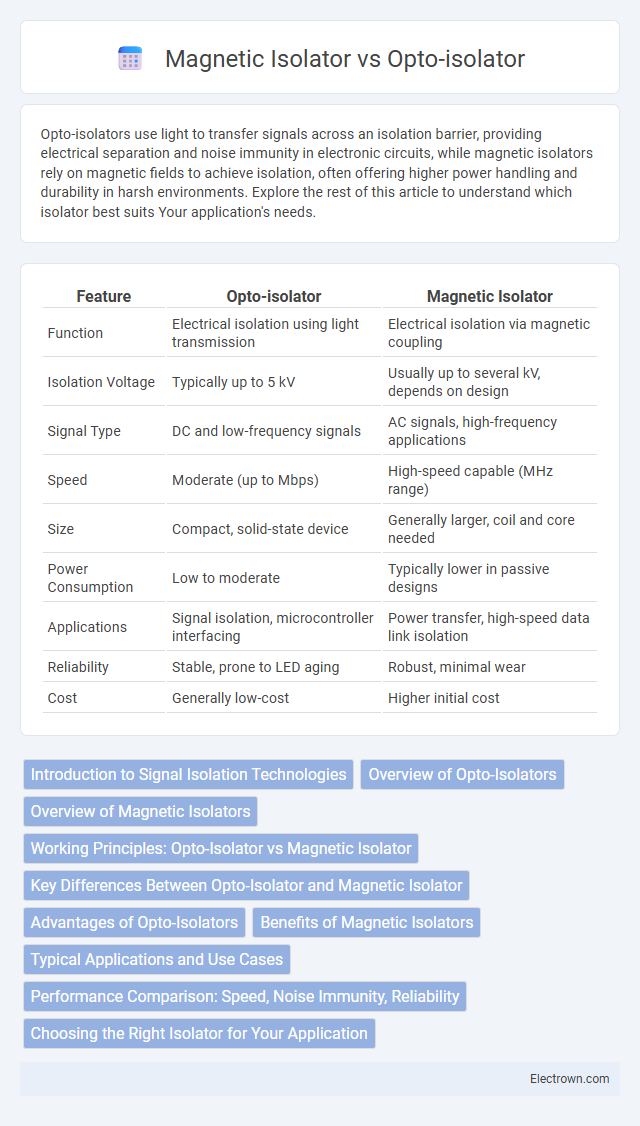Opto-isolators use light to transfer signals across an isolation barrier, providing electrical separation and noise immunity in electronic circuits, while magnetic isolators rely on magnetic fields to achieve isolation, often offering higher power handling and durability in harsh environments. Explore the rest of this article to understand which isolator best suits Your application's needs.
Table of Comparison
| Feature | Opto-isolator | Magnetic Isolator |
|---|---|---|
| Function | Electrical isolation using light transmission | Electrical isolation via magnetic coupling |
| Isolation Voltage | Typically up to 5 kV | Usually up to several kV, depends on design |
| Signal Type | DC and low-frequency signals | AC signals, high-frequency applications |
| Speed | Moderate (up to Mbps) | High-speed capable (MHz range) |
| Size | Compact, solid-state device | Generally larger, coil and core needed |
| Power Consumption | Low to moderate | Typically lower in passive designs |
| Applications | Signal isolation, microcontroller interfacing | Power transfer, high-speed data link isolation |
| Reliability | Stable, prone to LED aging | Robust, minimal wear |
| Cost | Generally low-cost | Higher initial cost |
Introduction to Signal Isolation Technologies
Opto-isolators and magnetic isolators represent key signal isolation technologies used to prevent electrical noise and ground loops in sensitive circuits. Opto-isolators employ light signals through LED-photodetector pairs to achieve galvanic isolation, making them ideal for low-frequency digital and analog signal transmission. Magnetic isolators, using transformers or inductive coupling, excel in providing high-frequency signal isolation with robust noise immunity and power transfer capabilities.
Overview of Opto-Isolators
Opto-isolators, also known as optocouplers, use light to transfer electrical signals between two isolated circuits, ensuring signal integrity while providing high electrical isolation. They consist of an LED and a photodetector within a single package, enabling fast response times and low power consumption ideal for data communications and noise-sensitive applications. Your designs benefit from opto-isolators' ability to protect sensitive components from voltage spikes and ground loops without direct electrical connection.
Overview of Magnetic Isolators
Magnetic isolators utilize magnetic fields to provide galvanic isolation between circuits, preventing direct electrical connection while allowing signal transmission. These devices excel in applications requiring high voltage isolation and robust noise immunity, often found in power supplies, industrial equipment, and communication systems. Their ability to transfer energy through magnetic coupling ensures minimal signal loss and enhanced safety in electrically noisy environments.
Working Principles: Opto-Isolator vs Magnetic Isolator
Opto-isolators operate by using light signals transmitted through an LED and a photodetector to achieve electrical isolation between input and output circuits, ensuring signal integrity without direct electrical connection. Magnetic isolators use transformers or inductive coupling to transfer signals or power via magnetic fields, providing isolation and noise immunity in power systems or data communication. Understanding these working principles helps you choose the right isolator based on factors like signal type, distance, and noise environment.
Key Differences Between Opto-Isolator and Magnetic Isolator
Opto-isolators use light to transmit signals across electrically isolating barriers, ensuring high noise immunity and fast response times ideal for signal isolation in electronic circuits. Magnetic isolators employ magnetic fields to transfer signals or power, providing strong isolation with the capability to handle higher voltage levels and offering robustness in harsh environments. Key differences include their isolation mechanism--optical versus magnetic--their typical applications, and performance characteristics related to speed, voltage handling, and electromagnetic interference tolerance.
Advantages of Opto-Isolators
Opto-isolators offer superior electrical noise immunity and faster response times compared to magnetic isolators, making them ideal for high-speed data transmission and sensitive signal isolations. Their compact size and low power consumption enhance integration into modern electronic circuits, while providing excellent voltage isolation up to several kilovolts. Opto-isolators also exhibit minimal signal distortion and robust performance in environments with electromagnetic interference, ensuring reliable and secure signal transfer.
Benefits of Magnetic Isolators
Magnetic isolators provide superior electrical isolation by using magnetic fields to transfer signals without direct electrical contact, thereby eliminating ground loops and enhancing noise immunity. They offer higher voltage isolation ratings, longer operational life due to non-contact operation, and improved reliability in harsh environments compared to opto-isolators. Their ability to handle higher data rates and lower signal distortion makes them ideal for industrial and high-precision applications.
Typical Applications and Use Cases
Opto-isolators are commonly used in signal isolation for microcontrollers, communication interfaces, and industrial automation systems to prevent high voltages from damaging sensitive components. Magnetic isolators excel in power line communication, high-frequency signal isolation, and wireless power transfer applications due to their ability to handle higher power levels and provide galvanic isolation without direct electrical contact. Both technologies enhance system safety and reliability but are selected based on specific voltage, frequency, and power requirements within fields like medical equipment, renewable energy systems, and data acquisition.
Performance Comparison: Speed, Noise Immunity, Reliability
Opto-isolators offer faster switching speeds typically in the microsecond range, making them suitable for high-speed digital communication, whereas magnetic isolators operate with switching speeds in the nanosecond range, providing superior performance for high-frequency applications. Magnetic isolators excel in noise immunity due to their inherent magnetic coupling, which reduces susceptibility to electromagnetic interference compared to opto-isolators that rely on light transmission and can degrade over time. Your choice should consider reliability factors; magnetic isolators generally provide longer operational life and stable performance in harsh environments, while opto-isolators may experience LED wear-out affecting long-term functionality.
Choosing the Right Isolator for Your Application
Opto-isolators use light to transmit signals between isolated circuits, providing excellent noise immunity and fast response times, ideal for low-voltage signal isolation. Magnetic isolators rely on magnetic fields to transfer signals, offering robust performance in high-power or noisy industrial environments with superior common-mode transient immunity. Your choice depends on factors such as signal type, voltage levels, isolation requirements, and environmental conditions to ensure optimal performance and reliability.
Opto-isolator vs Magnetic isolator Infographic

 electrown.com
electrown.com